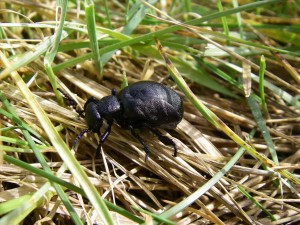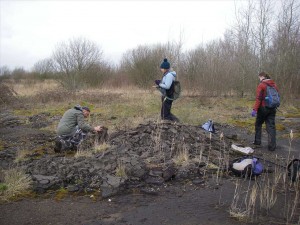
Despite a slow cold and slow start to the invertebrate season summer really is here and invertebrates are now out in abundance! I’ve had a busy few months so here are a few of the highlights. The winter and cool spring months involved continuing to learn about various groups of invertebrates and attempt to identify them. This took me to various museums and workshops and the great thing about Natural Talent is that it really opens doors for you. In the last few months I have been lucky enough to meet inspiring experts on beetles, spiders and solitary bees. Each time I have come away with not only a greater knowledge, but also a sense of their infectous passion for their specialist area. The variety of tasks and projects I have been involved with have been incredibly diverse including urban pond surveys, making bee banks, trying my hand at phase 1 habitat surveys of habitat and have helped to run a couple of events for TCV and attended some of the large summer shows with Buglife.
In March I made a trip down to England to visit a variety of different brownfield sites accompanying Buglife’s Entomologist Steven Falk. This began with a visit to Essex in search of oil beetles. These chunky and distinctive beetles are reliant on solitary mining bees and since they can’t fly they are very vulnerable to habitat fragmentation.
Oil beetles have an incredible life cycle which begins with the mother laying eggs in a burrow and the larvae (triangulans) must then climb up a plant to hitch a ride on a solitary bees to their nest. Once they arrive in the bee’s nest they feed on the pollen food stores the bee has provided for her own offspring. 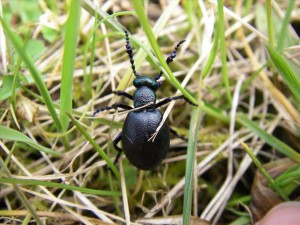
Once the adults emerge they start feeding on plants their abdomens extend giving a cartoonish bloated appearance.
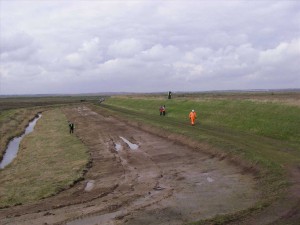
Sea defence bank supporting a nationally important Black oil beetle population.
The essex site had previously been used as farmland but is being cut through by the new railway developments. Coastal re-alignment is also going to take place so it was important to establish which areas supported the oil beetles so they could be protected. The Black oil beetle (Meloe proscarabaeus) was already known to be present, but the reason for the visit was to establish the extent of sea wall that was being used by the beetles. Our visit was timed perfectly and it was incredible ot see patches of the bank literally crawling with oil beetles.
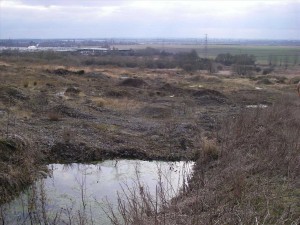
It may look more like a lunar landscape, but this is in fact great for invertebrates with a varied landscape and excellent plant diversity
Oil beetles are also found in Scotland and Buglife has recently launched its Scottish oil beetle hunt and is appealing to the public to submit records of the four species found in Scotland: http://www.buglife.org.uk/News/Join+the+Scottish+Oil+beetle+hunt.
The rest of the trip allowed me to see different brownfield sites and which features are most useful for invertebrates as well as talking about how these sites can be managed to maintain and maximise their potential for conservation.
One of the sites called Canvey Wick, which is on Canvey Island in Essex has been made a SSSI (Site of Special Scientific Interest) in official recognition for its importance, which is unusual for brownfield sites.
Canvey Wick will also have a moment of fame as it will soon appear in a documentary about insects with George McGavin. Despite being host to a phenomenal invertebrate diversity it was still challenging to find many bugs on Canvey Wick with the cold weather. During colder times invertebrates are usually well tucked away to avoid being caught in frost and being found by predators when they are unable to move quickly to escape. Mounds of rubble proved the most productive areas for finding bugs as they provide lots of crevices and hiding places for various species.
Over the last couple of months I have been able to start my own fieldwork. My project began by looking at all the known brownfield sites within the Inner Forth area, firstly by using aerial photography and then by actually visiting as many sites as possible. I have now decided which sites have the greatest potential for invertebrate biodiversity and I am using a variety of methods to collecting invertebrates.
To catch a bug, you have to think like a bug. Well sort of anyway. You need to think about what different groups of bugs need to survive and then you can target those habitats that provide it. I am using a variety of techniques to collect invertebrates, including placing pitfall traps (cups in the ground which roaming invertebrates will fall into) to collect ground beetles and spiders. Each method is usually only effective for certain invertebrate groups, so I will be employing a variety of other techniques to try to catch flying insects and those living on vegetation. So while entomologists may get strange looks as they beat bushes, run around with nets and crowd around glowing objects at night (moth traps), there is a good reason for all these seemingly bizarre activities!
Some large and brightly coloured groups like bumblebees and butterflies can be identified ‘in the field’ but most invertebrates can only be told apart by looking at tiny features under a microscope. Over the winter I was learning to identify spiders and ground beetles, as well looking at some of the other beetle families. The exciting thing about invertebrate surveys is that you never know what might turn up and the distribution of even fairly common species is often poorly known, so every survey is an adventure into an alien world.
That’s about it for now, but I’ll update you soon on some of the species I have been finding on my sites.
On Saturday Buglife and TCV will have stalls at a Bioblitz at the botanic gardens in Edinburgh, so please come along and join in the fun!
Niall
Urban Biodiversity Apprentice

